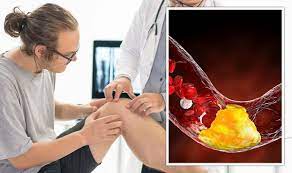Experts warn of ‘silent epidemic’ of high cholesterol in the UK

London: The most comprehensive research into cholesterol ever conducted in the UK has found 54% of Brits could have high total cholesterol levels. Now a medical expert says the recent switch from measuring LDL ‘bad’ cholesterol levels to a new ‘non-HDL’ test could be causing many Brits confusion.
October is Cholesterol Awareness Month, and a leading medical expert says increased awareness of this condition can’t come too soon. A quarter of a million volunteers have taken part in a huge testing program for blood pressure and cholesterol levels, and the results are very concerning.
Dr Avinash Hari Narayanan (MBChB), Clinical Lead at London Medical Laboratory, says: ‘27% of people taking part in Our Future Health’s new research program were found to have high blood pressure and a huge 54% were found to have high total cholesterol levels.
‘High cholesterol is a major underlying risk factor for cardiovascular disease (CVD), which is the leading cause of death worldwide, often leading to heart attacks and strokes. In England, high cholesterol leads to over 7% of all deaths and affects up to 60% of adults, according to NHS figures. Further research has revealed that, if 90% of people with CVD were identified and treated, almost 14,000 heart attacks, strokes and deaths would be prevented in three years.
‘With cholesterol levels having such a critical long-term impact on our overall health and 54% of us likely to have the condition, absolute clarity is needed in test results and interpretation. However, the UK has recently switched from the well-known and understood measurement of LDL (low-density lipoprotein), traditionally known as “bad” cholesterol, to a new measure. It’s vital that this change doesn’t confuse anyone receiving a test.
‘Previously, the focus of a cholesterol test was on our LDL (“bad”) cholesterol levels. That’s because not all cholesterol is a problem. It’s a natural fatty substance in our blood, produced in the liver and in some of the foods we eat, which helps to keep the cells in our bodies healthy. However, high LDL levels, uncontrolled, can increase our risk of heart attack and stroke.
‘Our LDL “bad” cholesterol levels used to be compared alongside our HDL (high-density lipoprotein) “good” cholesterol levels, as well as the total cholesterol level. Many people who are carefully watching their diet have become used to measuring their LDL levels over time as a key indicator of their potential health risks.
‘However, some researchers believe that measuring your “non-HDL” cholesterol levels gives a better assessment of the risk for heart disease than measuring only “bad” LDL levels. Because of this change, your “non-HDL” level is the measurement patients will probably be given now by their GPs.
‘Many people with high blood pressure will have become knowledgeable about LDL cholesterol, which makes up most of the body’s cholesterol. LDL carries cholesterol to the cells that need it. If there’s too much cholesterol for the cells to use it can build up in the artery walls, leading to disease of the arteries. In general, the higher your total and LDL cholesterol levels, the higher your risk for coronary heart disease. The former NHS guidance (still given by NHS Scotland) said LDL levels should be 3mmol/L or less.
‘However, the new non-HDL measure is very different. England’s NHS says, as a guide, your non-HDL cholesterol should be lower than 4mmol/L. That is potentially confusing, as a 4mmol/L reading of LDL would put you at a notably higher risk of cardiovascular disease.
‘So why has this change been made and are patients always clear about what their new measurements should be?
‘There are some good reasons for the change. Some heart attacks happen to people who don’t have a high LDL level. Researchers found we also need to consider other parts of “bad” cholesterol, known as VLDL (Very low-density lipoproteins), IDL (Intermediate-density lipoproteins) and lipoprotein(a), a type of LDL with an added protein. Previous testing also ignored triglyceride, another type of blood fat.
‘What do these new measurements tell us? VLDLs carry triglycerides and, to a lesser degree, cholesterol to our tissues. IDLs are created when VLDLs give up their fatty acids. They’re then either removed by our liver or converted into LDL. The added protein in lipoprotein(a) makes it stickier, narrowing arteries. It is thought to be largely caused by our genes rather than diet. Finally, triglycerides are another type of blood fat. If your triglycerides are high, it can mean you’re at risk of heart disease, liver disease and diabetes.
‘When you take the new test, as well as your new non-HDL reading, you will also be given an HDL (good cholesterol) and total cholesterol reading, which should be 5mmol/L or less. With cholesterol becoming something of a “silent epidemic”, impacting 1-in-2 people, the new, more accurate testing should be welcome. However, those used to checking their LDL “bad” cholesterols may feel confused or still wish to monitor this reading separately. Many people have monitored their LDL cholesterol levels for years, to see how diet and lifestyle are impacting their readings. Losing this continuity could potentially lead to complications.
‘Fortunately, there are some up-to-date tests that, while offering the new non-HDL measure, also continue to identify LDL “bad” cholesterol levels. For example, London Medical Laboratory’s Cholesterol Profile test is a revolutionary and convenient home-fingerprick test. It measures total cholesterol, LDL, HDL, non-HDL, triglycerides and two other key markers.
‘London Medical Laboratory’s fingerprick Cholesterol Profile test is considered the gold standard in regular testing. It is used to measure seven key biomarkers enabling people to make the positive lifestyle and dietary changes needed to improve their chances of a long and healthy life. It can be taken at home through the post, or at one of the many drop-in clinics that offer these tests across London and nationwide in over 95 selected pharmacies and health stores.





